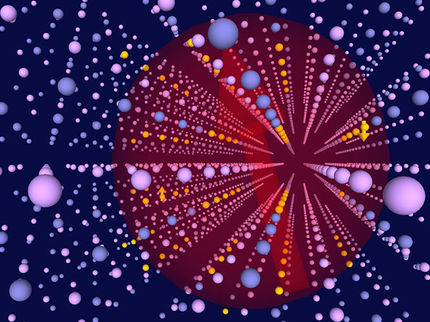Switching electron properties on and off individually
Properties of complex materials are often determined by the interplay of several electron properties. TU Wien (Vienna) has now succeeded in disentangling this mess.
Only at extremely low temperatures does order prevail. At the Vienna University of Technology, materials are cooled to almost absolute zero, so that electrons, which otherwise occupy different states quite randomly, show certain regularities. But even the behaviour of such extremely cold electrons is difficult to understand, on the one hand because the electrons strongly influence each other and cannot be described separately, and on the other hand because different electron characteristics play a role at the same time. However, the understanding is now made easier by experiments at the TU Vienna: It was possible to influence different characteristics of the electrons separately from each other. Closely interwoven quantum phenomena can thus be understood individually. The results have now been published in the journal PNAS.
Chess pieces and electrons
Imagine we have a big bag of chess pieces that you place on a chess board one after the other until it is full. There are different ways to create ordered patterns: For example, you can always place a white and a black piece alternately. You can also ignore the colors and alternately place a knight and a rook, or think up more complicated order patterns that combine color and figure type.
It is similar with electrons in a solid: As in a chessboard, there are regularly arranged places where electrons can sit. And like chess pieces, electrons have different properties that can be used to create order.
"The simplest property of the electrons is their charge - it is responsible for the flow of electric current. However, the charge is the same for all electrons," says Prof. Silke Bühler-Paschen from the Institute of Solid State Physics at the TU Vienna. "Things become more interesting if we also consider the electron spin. For the spin, there are always two different possibilities. Its magnetic properties are determined by the regular arrangement of electron spins in a solid body".
Where is the electron located? The orbital degree of freedom
However, for localized electrons there is another property, another degree of freedom, which plays an important role: The orbital degree of freedom. If an electron is bound to a certain atom, different spatial arrangements are possible. Quantum physics allows for different geometric relationships between electron and atom - and this also allows for ordered structures in the solid, for example when many identical atoms are arranged in a crystal, and each has an electron that is in the same orbital state.
"We investigated a material made of palladium, silicon and cerium," says Silke Bühler-Paschen. "We focus on the electrons located at the cerium atom and on the conduction electrons, which can move freely through the crystal.” With the help of conduction electrons, it is possible to influence the order of the electrons at the cerium atom - both their spin degree of freedom and their orbital degree of freedom. "This is done by shielding," explains Bühler-Paschen. "The conduction electrons can virtually hide both the spin and the orbital state of the fixed electrons, which is called the Kondo effect. This means that order is no longer possible." As has now been shown, the order of these two degrees of freedom can be switched on and off separately at very low temperatures - with the help of tiny magnetic field changes.
"The fact that order in quantum systems collapses or reappears in certain situations is not new," says Silke Bühler-Paschen. "But here we have a system in which the order can be switched on and off individually in relation to two different degrees of freedom that are closely interwoven at high temperatures - and that is quite remarkable.”
This possibility could now help to uncover particularly interesting properties of complex materials. "There are reasons to assume that the orbital degree of freedom also plays an important role in the phenomenon of unconventional superconductivity," says Silke Bühler-Paschen. "We now have a new instrument at our disposal to better understand such technologically important effects."
Original publication
Most read news
Original publication
Organizations
Other news from the department science

Get the chemical industry in your inbox
By submitting this form you agree that LUMITOS AG will send you the newsletter(s) selected above by email. Your data will not be passed on to third parties. Your data will be stored and processed in accordance with our data protection regulations. LUMITOS may contact you by email for the purpose of advertising or market and opinion surveys. You can revoke your consent at any time without giving reasons to LUMITOS AG, Ernst-Augustin-Str. 2, 12489 Berlin, Germany or by e-mail at revoke@lumitos.com with effect for the future. In addition, each email contains a link to unsubscribe from the corresponding newsletter.

























































